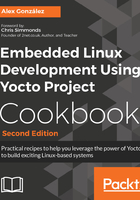
How it works...
The setup-environment script is a wrapper around the oe-init-build-env we used before. It will create a build directory, set up the MACHINE variable and DISTRO with the provided values, and prompt you to accept the NXP EULA as described earlier. Your conf/local.conf configuration file will be updated both with the specified machine and the EULA acceptance variable. To accept the license, the following line has been automatically added to the project's conf/local.conf configuration file:
ACCEPT_FSL_EULA = "1"
$ cd /opt/yocto/fsl-community-bsp/
$ source setup-environment wandboard
The preceding BitBake command creates a core-image-minimal-wandboard.wic.gz file, that is, a compressed WIC file, inside the tmp/deploy/images/wandboard folder.
A WIC file is created by Yocto using the WIC tool and it is a partitioned image from Yocto build artifacts that can then be directly programmed.
This image can be programmed into a microSD card, inserted in the primary slot in the Wandboard CPU board (the one in the side of the i.MX6 SoM and under the heatsink), and booted using the following commands:
$ cd /opt/yocto/fsl-community-bsp/wandboard/tmp/deploy/images/wandboard/ $ sudo bmaptool copy --nobmap core-image-minimal-wandboard.wic.gz /dev/sdN
Here, /dev/sdN corresponds to the device node assigned to the microSD card in your host system.
$ sudo apt-get install bmap-tools
bmaptool will refuse to program mounted devices and it will complain with:
bmaptool: ERROR: cannot open block device '/dev/sdN' in exclusive mode: [Errno 16] Device or resource busy: '/dev/sdN'
You will need to unmount the SD card if Ubuntu auto mounted it with:
$ sudo umount /dev/sdN
Here, N is a letter assigned by the Linux kernel. Check the dmesg to find out the device name.
The --nobmap option passed to bmaptool requires some explanation. bmaptool is a utility specialized in copying data to block devices, similar to the traditional dd command. However, it has some extra functionality that makes it a very convenient tool to use in embedded device development work:
- It is able to copy from compressed files, as we can see with the wic.gz file
- It is able to use a BMAP file to speed up the copying of sparse files
When data is stored in a filesystem, blocks of data are mapped to disk sectors using an on-disk index. When a block of data is not mapped to any disk sector, it's called a hole, and files with holes are called sparse files. A BMAP file provides a list of mapped areas as well as checksums for both the BMAP file itself and the mapped areas.
Using this BMAP file, bmaptool can significantly speed up the process of copying sparse files.
However, as we are not using a BMAP file, we pass the --nobmap file and use bmaptool for the convenience of using a compressed file. It also has other optimizations over dd that make it a better tool for the job.